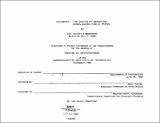| dc.contributor.advisor | Shun Kanda. | en_US |
| dc.contributor.author | Zimmerman, Lee Zaurie | en_US |
| dc.coverage.spatial | n-us-ma | en_US |
| dc.date.accessioned | 2013-05-06T17:29:05Z | |
| dc.date.available | 2013-05-06T17:29:05Z | |
| dc.date.copyright | 1980 | en_US |
| dc.date.issued | 1980 | en_US |
| dc.identifier.uri | http://hdl.handle.net/1721.1/78744 | |
| dc.description | Thesis (M. Arch.)--Massachusetts Institute of Technology, Dept. of Architecture, 1980. | en_US |
| dc.description | MICROFICHE COPY AVAILABLE IN ARCHIVES AND ROTCH. | en_US |
| dc.description | Includes bibliographical references (p. 92-97). | en_US |
| dc.description.abstract | Our society places greater value on individualism and privacy than on sharing and public use of space. This attitude is apparent in the form of our physical environment. Given the need for spontaneous, informal bonds of community and the increasingly privatized environment in which we live, architects must strive to provide opportunities for social interaction in the public realm. For this to occur, the public structure must be legible, accessible and foster a sense of place. Of the many ways to encourage such interaction, this thesis chooses to demonstrate, through design studies, one attitude calling for a spatially-defined edge-zone between buildings and public paths. This means imbuing a path with qualities of place and providing transactional zones rather than abrupt boundaries along enclosure walls. Operating at both large and small scales, architectural design studies and accompanying text describe possible ways of applying this attitude. At the urban scale, the thesis project addresses the extension of the Charles River basin water-edge pedestrian use zone, structuring the margin between the busy roads surrounding the basin and the water itself. Within the Charles basin context, I have proposed a scheme for a new museum of science and housing complex on the site of the Charles River dam. A major portion of the thesis focuses on the design of two very different edge-zones mediating between the architecture and the public paths that move along it; the sky lit Passage between parts of the museum and housing descending from an elevated transit stop to the water's edge and the Promenade a long a south-facing expanse of river next to an auditorium, cafe and sluice. "Biographies" of the elements forming the edgeways explain the design process at each stage. | en_US |
| dc.description.statementofresponsibility | by Lee Zaurie Zimmerman. | en_US |
| dc.format.extent | 97 p. | en_US |
| dc.language.iso | eng | en_US |
| dc.publisher | Massachusetts Institute of Technology | en_US |
| dc.rights | M.I.T. theses are protected by
copyright. They may be viewed from this source for any purpose, but
reproduction or distribution in any format is prohibited without written
permission. See provided URL for inquiries about permission. | en_US |
| dc.rights.uri | http://dspace.mit.edu/handle/1721.1/7582 | en_US |
| dc.subject | Architecture | en_US |
| dc.subject.lcsh | Open spaces | en_US |
| dc.subject.lcsh | Open spaces Massachusetts Cambridge | en_US |
| dc.subject.lcsh | City planning Massachusetts | en_US |
| dc.subject.lcsh | City planning Massachusetts Cambridge | en_US |
| dc.title | Edgeways : the design of mediating zones along public paths | en_US |
| dc.type | Thesis | en_US |
| dc.description.degree | M.Arch. | en_US |
| dc.contributor.department | Massachusetts Institute of Technology. Department of Architecture | |
| dc.identifier.oclc | 07346764 | en_US |
